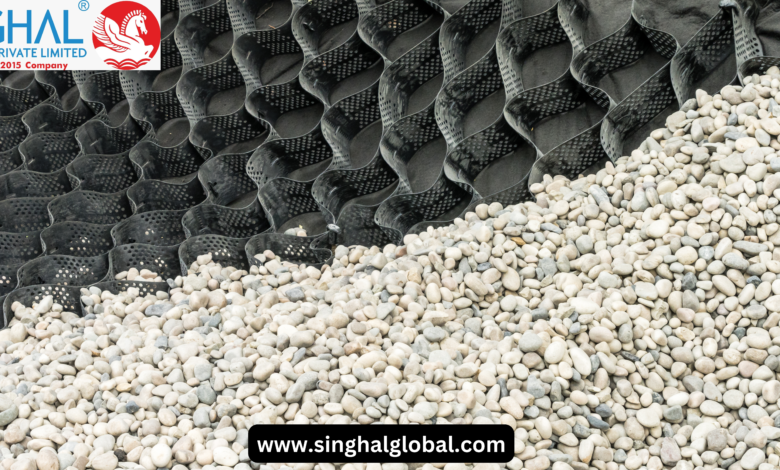Discover the Potential of Geocells for Erosion Control and Load Distribution

Geocells are a form of cellular confinement system primarily used to stabilize and reinforce terrain. Geocell suppliers in Delhi versatile products have become increasingly popular due to their durability and efficiency in providing structural support across a wide range of projects.
Types of Geocells
There are several types of geocells available, each designed for specific applications and environments. The two main categories are standard and high-performance geocells.
Applications of Geocells
Geocells offer exceptional versatility and have a broad range of applications across different construction and environmental projects. Here are some of the key areas where geocells are commonly used:
Geocells in Road Construction
Geocells are frequently employed in road construction to reinforce and stabilize the subbase and subgrade layers. By distributing loads effectively, they help prevent rutting and cracking, which significantly enhances road durability. In areas with soft or unstable soil, geocells improve load-bearing capacity and make construction possible where traditional methods may fail.
Geocells in Erosion Control
One of the primary uses of geocells is for erosion control. By confining soil within their cellular structure, geocells help prevent soil displacement caused by water and wind. This makes them ideal for protecting slopes, riverbanks, and other areas prone to erosion, reducing the environmental impact and maintaining the integrity of landscapes.
Use of Geocells in Earth Retention
Geocells serve as reliable earth retention solutions, particularly for retaining walls and embankments. They stabilize the soil, reduce pressure on retaining walls, and allow for steeper and more stable slopes, which can be a crucial advantage in hilly or mountainous terrains.
Applications in Slope Protection
Slope stability is a significant concern in construction and landscaping projects. Geocells help anchor slopes, prevent landslides, and reduce surface erosion by holding soil in place, making them ideal for projects that involve steep or unstable slopes.
Benefits of Using Geocells
Geocells are not only versatile but also offer numerous benefits that make them an attractive choice for various projects.
Durability and Strength
Geocells are made from high-density polyethylene (HDPE) or other tough polymers, making them highly durable and resistant to environmental stressors. This resilience enables geocells to maintain their structural integrity under heavy loads and extreme conditions, providing a reliable long-term solution.
Cost-Effectiveness
Compared to traditional reinforcement methods, geocells can significantly reduce material and labor costs. They are lightweight and easy to transport, and their installation often requires less preparation and fewer materials than alternative solutions, resulting in cost savings.
Environmental Benefits
Geocells are eco-friendly, as they often require less concrete and other non-renewable materials. Their ability to prevent erosion also helps preserve natural habitats and reduce sediment runoff, contributing to environmental sustainability.
How Geocells Work
The science behind geocells lies in their ability to confine and stabilize soil or aggregate materials. When filled, the interconnected cells distribute applied loads horizontally, minimizing the stress on underlying soil. This effect improves load-bearing capacity, reduces settlement, and enhances structural performance.
Structural Integrity and Load Distribution
The cellular structure of geocells helps distribute loads evenly across a larger area. This is particularly beneficial in applications like road construction, where maintaining even load distribution can prevent surface deformation and increase the lifespan of the road.
Geocell Installation Process
Installing geocells involves several steps, from site preparation to securing the cells. Proper installation is crucial for achieving the desired performance and longevity.
Preparation for Installation
Before installation, it’s essential to assess the site, remove any debris, and level the ground. In some cases, a layer of Geocell installation in India is placed beneath the geocells to further enhance stability.
Step-by-Step Geocell Installation
- Placement: The geocell panels are laid out over the prepared surface and expanded to cover the designated area.
- Anchoring: The geocells are then anchored to the ground using stakes or pins to prevent movement during filling.
- Filling: Once secured, the cells are filled with soil, gravel, or other aggregate materials. It’s important to fill the cells evenly to maintain uniform strength and stability.
- Compaction: After filling, the material is compacted to ensure optimal load-bearing capacity and reduce voids within the cells.
Common Installation Challenges
Some challenges during installation include handling large or uneven areas, managing water flow, and ensuring proper cell expansion. Adequate planning and using the right tools can help overcome these issues.
Key Considerations for Geocell Installation
Selecting the right geocell depends on factors such as project scope, load requirements, and environmental conditions.
Selecting the Right Geocell for the Project
Geocells come in various cell sizes and thicknesses. Choosing the right specification is critical to meeting the load and durability requirements of your project. Consulting with experts or suppliers can help ensure the appropriate geocell is used.
Site Conditions and Soil Quality
Soil type and conditions play a significant role in geocell performance. In areas with weak or loose soil, additional stabilization measures may be required to ensure the cells perform effectively.
Geocell Costs and Pricing
Geocell costs can vary depending on material quality, cell size, and project scale. While they are generally more affordable than traditional reinforcement methods, understanding the factors affecting pricing can help in budget planning.
Factors Affecting Geocell Pricing
Several factors influence the cost of geocells, including material thickness, cell size, and shipping costs. Additionally, installation complexity and site preparation requirements can impact overall expenses.
Average Geocell Price Range
While prices vary, typical geocell systems can range from $2 to $5 per square foot. Bulk purchases or larger projects may qualify for discounts, so it’s worth inquiring about volume pricing.
Cost Comparison with Other Reinforcement Solutions
Geocells often present a more economical choice compared to concrete or metal reinforcement systems. Their ease of installation and lower maintenance needs further contribute to long-term savings.
Geocell Quality and Standards
Geocells must meet certain quality standards to ensure their effectiveness. High-quality geocells are usually tested for tensile strength, UV resistance, and durability.
How to Evaluate Geocell Quality
Look for geocells that meet industry standards, such as ASTM or ISO certifications. Checking reviews and consulting with professionals can also provide insights into the quality and performance of specific brands or models.
Environmental Impact of Geocells
Geocells are considered environmentally friendly due to their sustainability and reduced need for raw materials.
Sustainability and Eco-Friendly Properties
By requiring fewer raw materials and minimizing erosion, geocells help reduce environmental footprints. They are also recyclable, adding another layer of eco-friendliness to their benefits.
Comparison with Traditional Reinforcement Materials
Compared to concrete and metal, geocells have a significantly lower carbon footprint. Their lighter weight and reduced transport needs further enhance their environmental appeal.
Maintenance and Durability of Geocells
With proper installation, geocells are highly durable and require minimal maintenance.
How Long Do Geocells Last?
Geocells can last for several decades, depending on environmental conditions and usage. Regular inspections and minor maintenance can help extend their lifespan.
Maintenance Tips for Longevity
Inspecting the geocells periodically for signs of damage or wear, particularly after extreme weather, can help ensure they continue to perform well. Minor repairs or reinforcements can also prevent larger issues down the line.
Future of Geocell Technology
Innovations in geocell design continue to emerge, with advancements focusing on enhanced materials, improved sustainability, and increased load-bearing capabilities.
Predicted Trends in Geocell Usage
Future trends may include increased use of Geocell price in Gujarat in urban areas for green infrastructure projects, as well as advancements in biodegradable materials for temporary applications.
Conclusion
In summary, geocells offer a versatile, cost-effective, and environmentally friendly solution for various construction and landscaping projects. Their durability, ease of installation, and sustainability make them a popular choice for modern engineers and environmentalists alike.
FAQs About Geocells
What is a geocell, and how does it work?
A geocell is a cellular confinement system that stabilizes and reinforces soil or aggregate by distributing loads across its structure.
Are geocells suitable for residential landscaping projects?
Yes, geocells are often used for landscaping to stabilize soil, prevent erosion, and create aesthetically pleasing, durable surfaces.
How do I install geocells for a driveway?
Follow a step-by-step process that includes site preparation, securing the geocells, filling the cells, and compacting the material for stability.
Can geocells be used with any type of soil?
While geocells can work with most soil types, the soil quality and conditions may require specific preparation or additional stabilization measures.
How much does it cost to install geocells?
Costs can vary, but generally, geocell installation ranges from $2 to $5 per square foot, depending on the project specifics.




